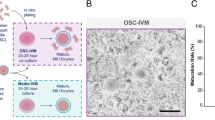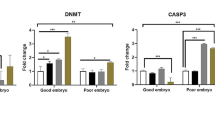Abstract
It has been long-known that endometrium-secreted cytokines play a critical role during embryo implantation. However, whether cytokines secreted from the embryo are relevant to the process of embryo implantation remains unclear. The concentration of cytokines in embryo culture medium was tested using a newly developed, high-sensitivity single-cell proteomic platform and evaluated in comparison to embryo quality and clinical outcome. The effect of TNF-α on embryo and endometrium Ishikawa cells was investigated using immunofluorescence staining, CCK-8 assay, TUNEL staining, and RT-qPCR. Of the 10 cytokines measured, only TNF-α concentration was significantly higher in the group with embryo implantation failure. Immunofluorescence staining showed that the expression of TNF-α was unevenly distributed in blastocysts, and the expression level was significantly correlated with the blastocyst inner cell mass (ICM) quality score. Gene profiling showed that addition of TNF-α led to increased expression of tumor necrosis factor receptor 1 (TNFR1) and apoptosis-related genes and that this could be inhibited by the TNF-α receptor inhibitor etanercept (ETA). In addition, an increased expression of water and ion channels, including AQP3, CFTR, ENaCA, and CRISP2 was also observed which could also be inhibited by ETA. Our results show that higher embryo-secreted TNF-α levels are associated with implantation failure through activation of TNF-α receptor, and TNF-α may be an independent predictor for pre-transfer assessment of the embryo development potential in IVF patients.




Similar content being viewed by others
Change history
16 February 2022
A Correction to this paper has been published: https://doi.org/10.1007/s43032-022-00886-2
Abbreviations
- TNF-α:
-
tumor necrosis factor alpha
- ICM:
-
blastocysts inner cell mass
- TM:
-
trophectoderm of the embryo
- ETA:
-
etanercept
- TNFR1:
-
tumor necrosis factor receptor 1
- TNFR2:
-
tumor necrosis factor receptor 2
- CFTR:
-
cystic fibrosis transmembrane conductance regulator
- ENaCA:
-
epithelial Na (+) channel subunit alpha
- AQP3:
-
aquaporin-3
- CRISP2:
-
cysteine-rich secretory protein 2
- LIF:
-
leukemia inhibitory factor
- CRYBB2:
-
beta-crystallin B2
- Th1/2:
-
helper T cells 1/2
- IL-1β:
-
interleukin-1 beta
- IL-6:
-
interleukin-6
- IL-8:
-
interleukin-8
- IL-10:
-
interleukin-10
- MCP1:
-
monocyte chemotactic protein 1
- MIP-1α:
-
macrophage inflammatory protein 1-alpha
- MIP-1β:
-
macrophage inflammatory protein 1-beta
- RANTES:
-
C-C motif chemokine 5, T-cell-specific protein
- GM-CSF:
-
granulocyte-macrophage colony-stimulating factor
- NF-κB:
-
nuclear factor of kappa light polypeptide gene enhancer in B-cells 3
- IVF:
-
in vitro fertilization
- ICSI:
-
intracytoplasmic sperm injection
- ART:
-
assisted reproductive technology
- ROC:
-
receiver operating characteristic curve
- PCOS:
-
polycystic ovary syndrome
References
Szekeres-Bartho J, Šućurović S, Mulac-Jeričević B. The role of extracellular vesicles and PIBF in embryo-maternal immune-interactions. Front Immunol. 2018;9:2890.
Yang M, Chen Y, Chen L, Wang K, Pan T, Liu X, et al. miR-15b-AGO2 play a critical role in HTR8/SVneo invasion and in a model of angiogenesis defects related to inflammation. Placenta. 2016;41:62–73.
Xue Q, Lu Y, Eisele MR, Sulistijo ES, Khan N, Fan R, et al. Analysis of single-cell cytokine secretion reveals a role for paracrine signaling in coordinating macrophage responses to TLR4 stimulation. Sci Signal. 2015;8(381):ra59.
He B, Zhang H, Wang J, Liu M, Sun Y, Guo C, et al. Blastocyst activation engenders transcriptome reprogram affecting X-chromosome reactivation and inflammatory trigger of implantation. Proc Natl Acad Sci U S A. 2019;116(33):16621–30.
Coughlan C, Ledger W, Wang Q, Liu F, Demirol A, Gurgan T, et al. Recurrent implantation failure: definition and management. Reprod BioMed Online. 2014;28(1):14–38.
Jin XY, Zhao LJ, Luo DH, Liu L, Dai YD, Hu XX, et al. Pinopode score around the time of implantation is predictive of successful implantation following frozen embryo transfer in hormone replacement cycles. Hum Reprod. 2017;32(12):2394–403.
Horton J, Sterrenburg M, Lane S, Maheshwari A, Li TC, Cheong Y. Reproductive, obstetric, and perinatal outcomes of women with adenomyosis and endometriosis: a systematic review and meta-analysis. Hum Reprod Update. 2019;25(5):592–632.
Gu XW, Yang Y, Li T, Chen ZC, Fu T, Pan JM, et al. ATP mediates the interaction between human blastocyst and endometrium. Cell Prolif. 2020;53(2):e12737.
Li X, Wu C, Shen Y, Wang K, Tang L, Zhou M, et al. Ten-eleven translocation 2 demethylates the MMP9 promoter, and its down-regulation in preeclampsia impairs trophoblast migration and invasion. J Biol Chem. 2018;293(26):10059–70.
Lee MS, Hsu W, Huang HY, Tseng HY, Lee CT, Hsu CY, et al. Simultaneous detection of two growth factors from human single-embryo culture medium by a bead-based digital microfluidic chip. Biosens Bioelectron. 2020;150:111851.
Li L, Dong J, Yan L, Yong J, Liu X, Hu Y, et al. Single-cell RNA-seq analysis maps development of human germline cells and gonadal niche interactions. Cell Stem Cell. 2017;20(6):858–873.e4.
Li L, Guo F, Gao Y, Ren Y, Yuan P, Yan L, et al. Single-cell multi-omics sequencing of human early embryos. Nat Cell Biol. 2018;20(7):847–58.
Leng L, Sun J, Huang J, Gong F, Yang L, Zhang S, et al. Single-cell transcriptome analysis of uniparental embryos reveals parent-of-origin effects on human preimplantation development. Cell Stem Cell. 2019;25(5):697–712.e6.
Ji Y, Qi D, Li L, Su H, Li X, Luo Y, et al. Multiplexed profiling of single-cell extracellular vesicles secretion. Proc Natl Acad Sci U S A. 2019;116(13):5979–84.
Aberkane A, Essahib W, Spits C, et al. Expression of adhesion and extracellular matrix genes in human blastocysts upon attachment in a 2D co-culture system. Mol Hum Reprod. 2018;24:375–87.
Jiali C, Lanlan L, Yuqin H, Xiaoming J, Huiling Q, Aiguo S, et al. Polychlorinated biphenyls impair endometrial receptivity in vitro via regulating mir-30d expression and epithelial mesenchymal transition. Toxicology. 2016;365:25–34.
Leilani LS, Cheuk KL, Evdokia D. Tripeptidyl peptidase I promotes human endometrial epithelial cell adhesive capacity implying a role in receptivity. Reprod Biol Endocrinol. 2020;18(1):124.
Gardner DK, Schoolcraft WB. Culture and transfer of human blastocysts. Curr Opin Obstet Gynecol. 1999;11(3):307–11.
Yahui J, Dongyuan Q, Linmei L, Haoran S, Xiaojie L, Yong L, et al. Multiplexed profiling of single-cell extracellular vesicles secretion. PNAS. 2019;116(13):5979–84.
Bufang X, Mingjuan Z, Jingwen W, Dan Z, Feng G, Chenchen S et al. Increased AIF-1-mediated TNF-α expression during implantation phase in IVF cycles with GnRH antagonist protocol
Liu B, Maekawa T, Yoshida K, Ly NH, Inoue K, Hasegawa A, et al. Telomere shortening by transgenerational transmission of TNF-α-induced Terra via ATF7. Nucleic Acids Res. 2019;47(1):283–98.
Guanyou H, Congrong Z, Chi-Ju W, Shuyun Z, Fa S, Hua Z, et al. Evaluation of in vitro fertilization outcomes using interleukin-8 in culture medium of human preimplantation embryos. Fertil Steril. 2017;107(3):649–56.
Robertson SA, Chin PY, Femia JG, Brown HM. Embryotoxic cytokines-potential roles in embryo loss and fetal programming. J Reprod Immunol. 2018;125:80–8.
Chegini N, Dou Q, Williams RS. An inverse relation between the expression of tumor necrosis factor alpha (TNF-alpha) and TNF-alpha receptor in human endometrium. Am J Reprod Immunol. 1999;42(5):297–302.
Leaver M, Wells D. Non-invasive preimplantation genetic testing (niPGT): the next revolution in reproductive genetics? Hum Reprod Update. 2020;26(1):16–42.
Law TSM, Wu F, Xu H, Wang CC, Li TC. Endometrium imaging using real-time rotational optical coherence tomography imaging system: a pilot, prospective and ex-vivo study. Medicine (Baltimore). 2019;98(44):e17738.
Soni S, O’Dea KP, Tan YY, Cho K, Abe E, Romano R, et al. ATP redirects cytokine trafficking and promotes novel membrane TNF signaling via microvesicles. FASEB J. 2019;33(5):6442–55.
Günther C, Martini E, Wittkopf N, Amann K, Weigmann B, Neumann H, et al. Caspase-8 regulates TNF-α-induced epithelial necroptosis and terminal ileitis. Nature. 2011;477(7364):335–9.
Yamato F, Yasushi H, Mitsunori M, Mona G, Shun A, Takehiro H, Yutaka O. Uterine receptivity, embryo attachment, and embryo invasion: multistep processes in embryo implantation. Reprod Med Biol. 2019;18(3):234–40.
Giuseppe M, Francesca S, Miriam C, Andrea G, Ottavia M, Francesco P. Efficacy and safety of etanercept in chronic immune-mediated disease. Expert Opin Drug Saf. 2014;13(5):649–61.
Lang Q, Yidong X, Xueguang Z, Sixian W, Wenming X, Tao Z. ETA-mediated anti-TNF-alpha therapy ameliorates the phenotype of PCOS model induced by letrozole. PLoS ONE. 2019;14(6):e0217495.
Acknowledgements
We thank AIVFO (Inc., Chengdu, China) for providing technical support. Especially, we grateful for the technical assistance provided by Zhang Jie and Bo Lin in Histology and Imaging Platform, Core Facilities of West China Hospital, Sichuan University.
Funding
This work was supported by the National Key Research and Development Program of China (2018YFC1002804), Scientific and Translational Research Fund of Sichuan Provincial Department of Science and Technology (2017YSZH0032), the Key Research and Development Support Program of Chengdu (2019-YF05-00017-SN), and the Natural Sciences Foundation of China (81901435).
Availability of Supporting Data
The dataset used and/or analyzed during the current study is available from the corresponding author upon reasonable request. Registry data are available publicly (see references).
Author information
Authors and Affiliations
Contributions
WX and MZ developed the concept of the study; all authors contributed to data accumulation; JL and XS contributed to data analysis; all authors contributed to data interpretation. JL and WX wrote the manuscript. All authors contributed to revisions of the manuscript and approved the final submission. JL had full access to all the data in the study and takes responsibility for the integrity of the data and the accuracy of the data analysis.
Corresponding authors
Ethics declarations
Ethics Approval and Consent to Participate
The Second Affiliated Hospital of Chengdu University of Traditional Chinese Medicine Ethics Committee; approval number: 2017–01. Participants provided consent to participate in this study.
Consent for Publication
Not applicable.
Conflict of Interest
The authors declare no competing interests.
Additional information
Publisher’s Note
Springer Nature remains neutral with regard to jurisdictional claims in published maps and institutional affiliations.
Rights and permissions
About this article
Cite this article
Lv, J., Shan, X., Yang, H. et al. Single Cell Proteomics Profiling Reveals That Embryo-Secreted TNF-α Plays a Critical Role During Embryo Implantation to the Endometrium. Reprod. Sci. 29, 1608–1617 (2022). https://doi.org/10.1007/s43032-021-00833-7
Received:
Accepted:
Published:
Issue Date:
DOI: https://doi.org/10.1007/s43032-021-00833-7








